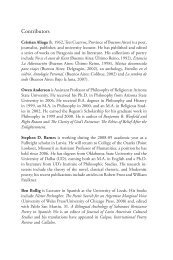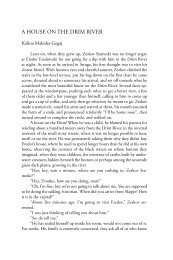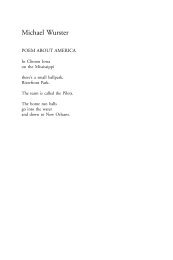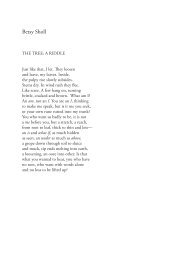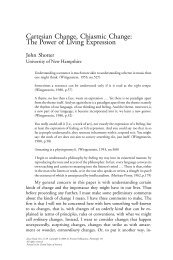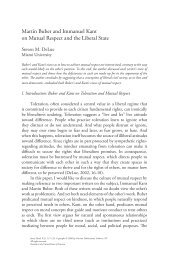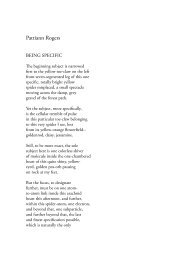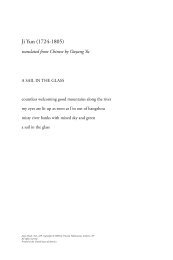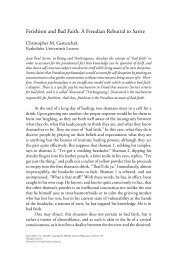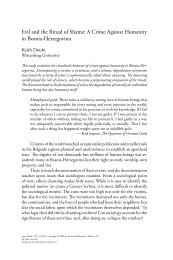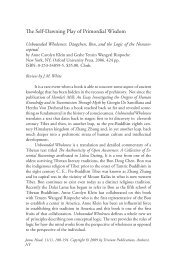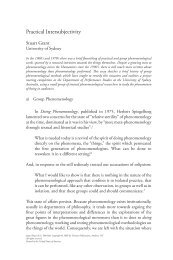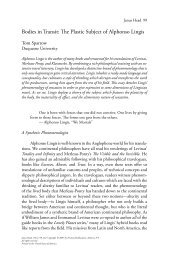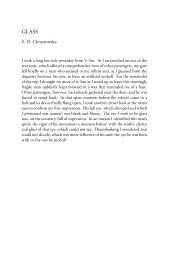Hesse's Steppenwolf: A Comic-Psychological ... - Janus Head
Hesse's Steppenwolf: A Comic-Psychological ... - Janus Head
Hesse's Steppenwolf: A Comic-Psychological ... - Janus Head
Create successful ePaper yourself
Turn your PDF publications into a flip-book with our unique Google optimized e-Paper software.
132 <strong>Janus</strong> <strong>Head</strong><br />
having any appreciation for the variety among items, and bars him from<br />
the fun of buying anything. Yet under Hermine’s direction, even the buying<br />
of the gramophone becomes a lesson in vitality and in the importance<br />
of things. Progress is slow, but Haller does finally learn to dance--not only<br />
the Fox Trot, which was the wolf’s first assignment, but the Boston as well.<br />
“Dancing, don’t you see,” Hermine tells him, “is every bit as easy as thinking<br />
. . .” (Hesse, 1974, p. 136). Learning to dance is Haller’s first step toward<br />
the reconciliation of his tortured duality.<br />
Her profession not withstanding, Hermine does not make love with<br />
Haller. Instead she sends her friend and lesbian lover, Maria, to instruct<br />
the <strong>Steppenwolf</strong> in the “charming play and delight of the senses” (Hesse,<br />
1974, p. 158). Maria, with her erotic wisdom and untainted innocence, also<br />
continues Haller’s education in the appreciation of the ways and things of<br />
what had been for him a decadent and superficial world. Haller “learned a<br />
great deal from Maria” (Hesse, 1974, p. 164).<br />
Above all else I learned that these playthings were not mere idle trifles<br />
invented by manufacturers. . . . �ey were, on the contrary, a little or, rather<br />
a big world, authoritative and beautiful, many sided containing a multiplicity<br />
of things all of which had the one and only aim of serving love, refining<br />
the senses, giving life to a dead world around us, endowing it in a magical<br />
way with new instruments of love, from powder and scent to the dancing<br />
show. . . . All were the plastic material of love, of magic and delight. (Hesse,<br />
1974, p. 164)<br />
Maria is an extension of the feminine constellation introduced to the<br />
novel by Hermine. Maria comes to the old wolf as a gift from Hermine<br />
and continues the instructions begun by her sister courtesan. Haller’s lessons<br />
in love, as Maria is well aware, will prepare him for a future, with a more<br />
complete union with Hermine. Hermine, Maria, and later Pablo form a<br />
triad who school the <strong>Steppenwolf</strong> in the arts of life and love, which he has<br />
forgotten. �ey reawaken and foster the <strong>Steppenwolf</strong>’s dormant aesthetic<br />
sensitivity, his ability to feelingly perceive his embodied existence. �rough<br />
this rekindled awareness, Haller is allowed entry into “the world of imagination.”<br />
After a passionate rendezvous with Maria, the <strong>Steppenwolf</strong> recollects:<br />
“�at night, however, gave me back my own life and made me recognize<br />
chance as destiny once more and see the ruins of my being as fragments of<br />
the divine” (Hesse, 1974, p. 162). “Destiny in the guise of Fortune,” writes<br />
Susan Langer, “is the fabric of comedy” (1958, p. 458).<br />
It was fortunate for Haller that he ended up in Hermine’s company




